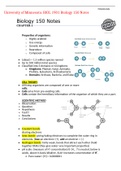Class notes
University of Minnesota: BIOL 1901 Biology 150 Notes,100% CORRECT
- Course
- Institution
University of Minnesota: BIOL 1901 Biology 150 Notes Properties of organisms: o Highly ordered o Use energy o Genetic information o Reproduce o Composed of cells • (about) ~ 1.5 million species named • Up to 100 million total species • Classified into 3 domains or 6 kingdoms ...
[Show more]



